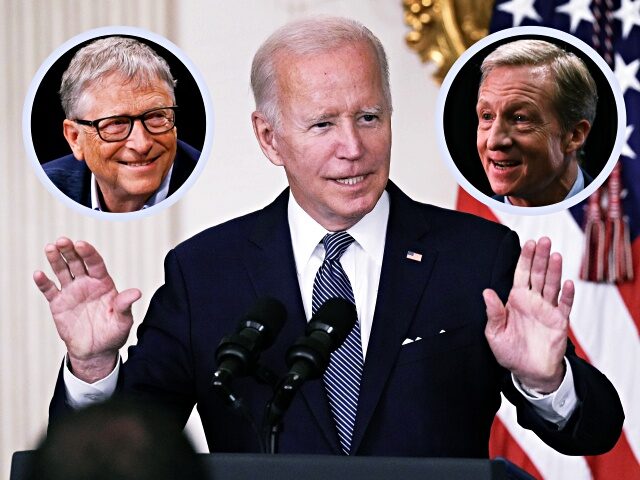But inflation at the grocery store continues to rise. Prices were up 1.3 percent compared with a month earlier and 13.1 percent compared with a year ago.
The cost of rent also increased by 0.7 percent from the previous month; 6.3 percent from the previous year.
VIDEOS
Richard D. Wolff | How Capitalism RIPS YOU OFF
https://www.youtube.com/watch?v=RX4MV4X6FkE
Richard D. Wolff | Capitalism is SLAVERY and THEFT
Mass Layoffs Are BOOMING! A New Housing Market Crash Is Starting To Pick Up Speed As Well
PHILADELPHIA PENNSYLVANIA WORST AREAS AT NIGHT
'City of a Thousand': Ep. 1 Downtown Phoenix's tent city explodes at alarming rate
IRS Whistleblower: ‘Billionaires … Laughing’ as Biden Plan Targets Working, Middle Class with Audits

A former lawyer for the Internal Revenue Service (IRS), who accused the agency of going after elderly Americans, says President Joe Biden’s “Inflation Reduction Act” will undoubtedly target working and middle class Americans with new IRS audits.
Biden’s Inflation Reduction Act, signed into law on Tuesday, includes $80 billion for new IRS audits on American taxpayers. The Congressional Budget Office (CBO) estimates that at least $20 billion will be taken from working and middle class Americans earning less than $400,000 a year as a result of the increased IRS audits.
William Henck, a former IRS lawyer, told Fox Business Network that executives at the biggest corporations and billionaires are “sitting back laughing right now” as Biden signs the Inflation Reduction Act.
“The idea that they’re going to open things up and go after these big billionaires and large corporations is quite frankly bulls–t. It’s not going to happen. They’re going to give themselves bonuses and promotions and really nice conferences,” Henck said:
“The big corporations and the billionaires are probably sitting back laughing right now,” he continued. [Emphasis added]
…
“There will be considerable incentive to basically to shake down taxpayers, and the advantage the IRS has is they have basically unlimited resources and no accountability, whereas a taxpayer has to weigh the cost of accountants, tax lawyers — fighting something in tax court,” Henck told FOX Business. [Emphasis added]
Billionaires Bill Gates and Tom Steyer have both voiced support for the Inflation Reduction Act, even as the establishment media has admitted the plan will not cut prices for American consumers “anytime soon.”
Henck said that despite claims from Biden and Democrats in Washington, D.C., that the new IRS audits will target the wealthiest of Americans, he warns that it is small business owners who will be hit the hardest — such as mom and pop shops, roofing companies, and local car dealerships.
An analysis from House Republicans projects that the Inflation Reduction Act will open hundreds of thousands of new IRS audits on working and middle class Americans:
The analysis, which is a conservative estimate based upon recent audit rates and tax filing data, shows that individuals with an annual income of $75,000 or less would be subject to 710,863 additional Internal Revenue Service (IRS) audits while those making more than $1 million would receive 52,295 more audits under the bill. The legislation, the Inflation Reduction Act, would roughly double the IRS’ budget to increase enforcement and, therefore, federal tax revenue. [Emphasis added]
Overall, the IRS would conduct more than 1.2 million more annual audits of Americans’ tax returns, according to the analysis. Another 236,685 of the estimated additional audits would target individuals with an annual income between $75,000 and $200,000. [Emphasis added]
Henck was forced out of his position at the IRS in 2017 after spending 30 years at the agency. He has accused the IRS of specifically targeting elderly Americans, including World War II veterans, with audits, while letting big companies off the hook.
John Binder is a reporter for Breitbart News. Email him at jbinder@breitbart.com. Follow him on Twitter here.
U.S. Retail Sales Indicate The Fed Has A Lot More Work To Do To Bring Down Inflation

The sharp decline in gasoline prices and a fall in sales of motor vehicle purchases left retail sales flat for July but consumer activity at other types of businesses picked up, a troubling sign for the Federal Reserve’s campaign to bring down inflation.
Sales across the retail sector in July were flat with the prior month, the Commerce Department said Wednesday. Compared with a year ago, sales are up 10.1 percent.
A big part of the flat-lining was due to falling sales as gas stations, similar to the way gas prices kept the headline inflation figure announced last week flat. Excluding gas stations, retail sales rose 0.4 percent in July.
Sales of motor vehicles and parts were down 1.7 percent for the month, despite a big increase in the production of cars and trucks reported by the Federal Reserve Tuesday.
Excluding autos and gasoline, sales were up 0.7 percent. Compared with year ago, retail sales minus gas and autos are up 9.3 percent.
Redefining ‘Recession’ for the Little People
On July 28, the Commerce Department announced that in the second quarter U.S. gross domestic product shrank by 0.9%. If that number isn’t revised upwards, it will mean that 2022 has been a year of negative growth. Two back-to-back quarters of negative growth, as we’ve now had, has long been considered the very definition of “recession.”
Preparing for the possibility of a second negative quarter of GDP with its negative implications for the midterm elections, Biden officials issued talking points to their minions that a recession is most definitely not two consecutive quarters of negative growth, but rather a complex combination of other factors that we proles needn’t concern ourselves with. However, “a recession by any other name” would smell as foul.
To be fair, maybe the classical definition of recession is a bit too simplistic. But it’s not as though GDP measures some discrete thing; GDP is whatever economists say it is. If they reconfigure GDP’s components, then its growth will be different.
The reason that the Bidenistas are so intent on redefining the word “recession” is because there is another economic indicator that cannot be redefined, and that’s “price inflation.” Though recession can be debated, the prices of energy and food can’t be; they are what they are, end of story. If a gallon of gasoline is $5, you won’t allow some pointy-headed policy wonk in D.C. to tell you different. That’s why the Democrats are so anxious to say we’re not in a recession, because having both inflation and recession going into an election smells too much like 1980.
Normal people might be a mite miffed at the Democrats for their infernal redefinitions. That’s because the Dems have been so consistently wrong lately about so many things that touch on the economy, especially their assurances that inflation would be transitory. Some analysts say that price inflation will be “sticky,” i.e. it will stick around for a while.
Recessions are officially dated by the National Bureau of Economic Research. Therefore, Biden can continue to deny that the U.S. is in a recession until the NBER chimes in, which, conveniently, won’t be until after the election.
The NBER may well side with Biden and rule that the U.S. was not in a recession during the first half of 2022. After all, it called the March-November period of 2001 a recession, despite its lack of two consecutive quarters of negative GDP. You see, the “Dot-Bomb [sic] Recession” of 2001 occurred under a new Republican president. And not only that, but the 2001 growth decline was only 0.3%, less than what we’ve had this year. One could be forgiven for wondering if the NBER has a bias.
Reminiscent of the stagflation of 40 years ago, Democrats are caught on the same sticky wicket of recession and inflation. But of these two, which is worse?
 If one has lost one’s job due to recession and is standing in a breadline, one might think that recession is surely the greater evil. But inflation hits everybody, including those who have managed to retain their job. Inflation is a cancer that can metastasize throughout an economy, and even destroy a nation’s currency.
If one has lost one’s job due to recession and is standing in a breadline, one might think that recession is surely the greater evil. But inflation hits everybody, including those who have managed to retain their job. Inflation is a cancer that can metastasize throughout an economy, and even destroy a nation’s currency.
If inflation is the greater evil, how do we deal with it while creating less pain for folks? To kill inflation, former Fed head Paul Volcker triggered two painful recessions by jacking up the federal funds interest rate to 20%. This writer knows of no one advocating such a stratospheric rate.
On July 28 at CNBC, economics professor Frederic Mishkin suggested that the Fed hike the funds rate to 4%. Mishkin didn’t explain why that number should be the target, but noted that it’s twice the Fed’s desired inflation rate of 2%.
Besides raising interest rates, there are two other ways to tackle inflation. The first is to attack inflation head-on by reducing the money supply, which the Fed does by reducing its balance sheet. We’re talking QT here, quantitative tightening, i.e. withdrawing money from the economy. The Fed hasn’t had much experience at QT nor has it been very good at it.
As this writer noted in July, the Fed acquired assets in the early days of the pandemic at a rate that is more than ten times faster than the rate it plans to reduce its balance sheet. Also, the Fed is unwinding its position passively, by letting securities mature and then run off. It’s called “portfolio runoff,” which means that the proceeds of maturing assets aren’t reinvested, they’re destroyed.
The Fed could be more aggressive in reducing its portfolio. If the Fed tries to control inflation with only interest rate hikes and passive portfolio runoff, we may be in for a more painful recession than is necessary. Given that, shouldn’t the Fed also reduce its balance sheet actively, by selling its assets prior to maturity? That way the Fed would be taking even more money out of the economy to fight inflation, and perhaps have less of a reason to raise interest rates to ruinous heights.
The second way to fight inflation is with the elective branches of government. Congress could end its excessive borrowing and spending, both of which contribute to rising prices. But with the passage of the Inflation Reduction Act, members of Congress seem to think that they can spend their way out of inflation. Indeed, Sen. Chuck Schumer once said that “the Fed is the only game in town.”
The president could help on the inflation front by reversing his disastrous policies on energy, but his handlers might not let him. So neither Congress nor the president are likely to deliver any relief. It seems the Fed really is the only game in town.
In combating inflation, Prof. Mishkin opined that the Fed needs to establish some “credibility,” as it had gotten “behind the curve,” and had been insufficiently “aggressive.” Correctamundo!
The Fed has been wrong and it’s been tardy. With an inflation rate of more than four times the 2% desired rate, the Fed can’t continue to pussyfoot around our inflation problem. To lessen the pain of recession, the Fed shouldn’t rely on passive portfolio runoff. The Fed also needs to actively sell the assets it bought with money it created. And, as with portfolio runoff, the Fed needs to destroy the proceeds of such sales. The Fed should rev up QT to soften the recession.
Recession is the price we pay for living beyond our means. Recession is a necessary corrective. Since the 2008 financial crisis, the federal government has borrowed, printed, and spent trillions of dollars to prop up the economy and asset prices. It needs to end.
If we want to kill inflation, rather than deny that we’re in recession, we should embrace recession, painful though it be. We must disabuse ourselves of the idea that we can continue running trillion-dollar deficits and printing a trillion dollars of new money in a single month.
Normal people should resent the Dems for their transparent attempt to control them by controlling the language and redefining inconvenient terms. They tell us that the invasion at the southern border is not an invasion and that the raid on President Trump’s home was not a raid. Who are these mental defectives trying to take over the mother tongue? If we allow them, the Left may even try to redefine “redefinition.”
Jon N. Hall of ULTRACON OPINION is a programmer from Kansas City.
Image: Public Domain Pictures
New York Fed’s Manufacturing Survey Shows Second Worst Crash Ever

Business activity in New York state suffered a severe and unexpected crash in August, a survey released Monday by the Federal Reserve Bank of New York showed.
The New York Fed’s Empire State Manufacturing Survey index of general business conditions plunged 42.4 points to negative 31.3.
This is the second largest monthly decline on record and among the lowest levels in the survey’s history. Only March and April of 2020 and February and March of 2009 were worse.
Economists had expected the index to dip to 5 from 11 in July.
The index for new orders dropped 35.8 points to negative 29.6, the lowest reading for this gauge outside of the lockdown period of March through May 2020. The index for shipments fell 49.4 points to negative 24.1. This indicates a sharp decline in both orders and shipments.
Unfilled orders dropped 12.7 points to negative 7.5, the third consecutive decline. The inventories index fell to 6.4, indicating that delivery times increased marginally.
Given the plunge in demand, it is not surprising that delivery times held steady. This was the first time in two years that delivery times did not worsen.
The prices paid index moved lower but remained elevated, pointing to a deceleration in input price increases. The prices received index held steady, indicating no let up in inflationary pressures on the sales side despite the crash in demand.
The index for the number of employees fell 11 points to 7.4, suggesting only a small increase in employment. The workweek index dropped, indicating a decline in the hours worked.
The index for future business conditions came in at 2.1, showing that manufacturers are not optimistic about the six-month outlook. Only modest increases in capital spending and technology spending are planned, the New York Fed said. Employment is expected to pick up and delivery times to decline. The indexes for new orders and shipments six-months from now were positive but at very low levels.
The New York Fed’s survey is seen as a bellwether for manufacturing conditions in the U.S. On Thursday, the Philadelphia Fed will release its index. Forecasts by economists issued prior to the New York Fed’s surprisingly deep plunge were for an improvement in the Philly Fed index from a negative 12.3 in July to negative five in August.